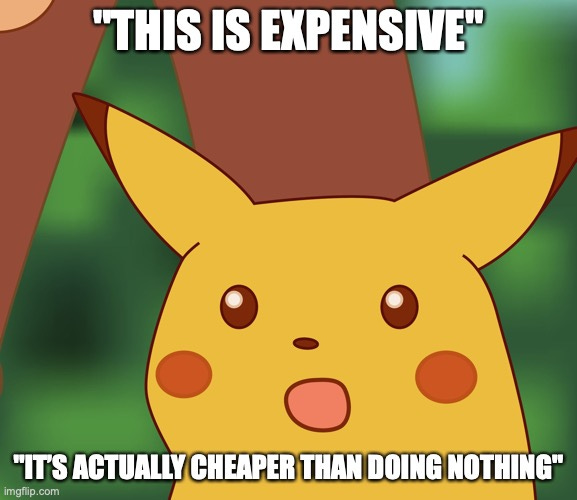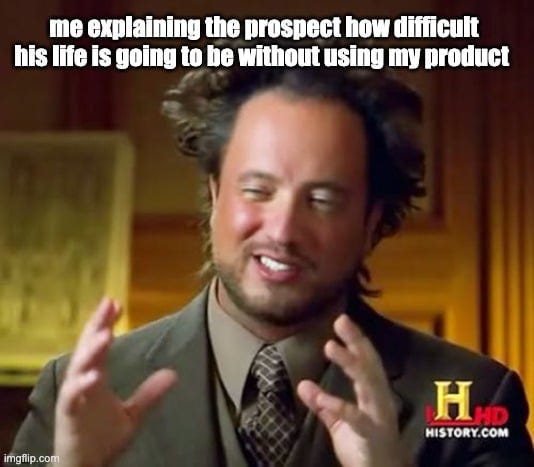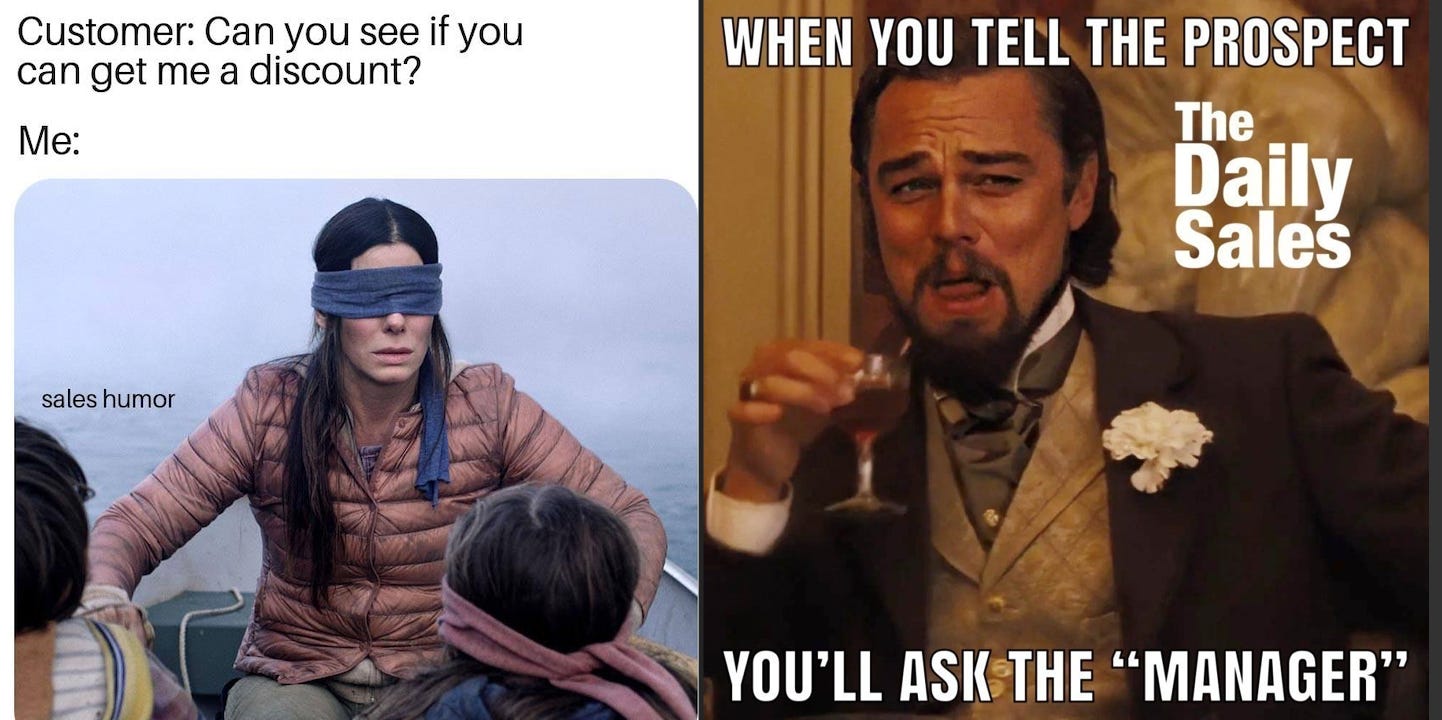10 Min Read – What You’ll Take Away
Simplify your outreach - get them on a call, not buried in homework:
Relatable Problem + Your Solution + Case Study.Segment by behavior, not borders - buying patterns don’t follow country lines.
Leverage FOMO - prospects follow what their peers and competitors use.
Tie pain to financial loss - if they don’t feel it in their numbers, they won’t fix it.
Talk about pricing early - qualify out the ones who can’t afford you.
Match value with the right stakeholder - CFOs need ROI, IT needs ease of integration.
Hold prospects accountable - remind them of their commitment.
You snooze, you lose - use scarcity and exclusivity to drive urgency.
Don’t let prospects move the goalposts - every extra request delays the deal.
Train reps with AI & mock conversations - don’t burn through real leads.
From Series A to Exit: Mastering Metrics
Reaching your next financial milestone doesn’t have to be a black box. In “From Series A to Exit: Mastering Metrics”, we break down what it takes to position your business as an attractive investment - whether for funding or a strategic exit. Each article focuses on a core pillar of success:
GTM: Sales - Basics,
Finance - Exit,
and People.
In addition to my own experience, my co-authors draw on their success stories from the likes of Uber, Booking, Dropbox, LinkedIn, Just Eat Takeaway, Lightspeed, Miro, EasyPark, Bynder, Squarespace, BlackRock, JP Morgan, Ares, and more.

GTM: Mastering Sales Metrics - Basics
Joining me for today’s dive are Richard De Veer and Igor Madzura.
Currently leading the commercial operation of JET Pay, Richard brings 25+ years of experience building high-performing Sales and RevOps teams at Just Eat Takeaway, LinkedIn, Lightspeed, eBay, PayPal, and Yahoo. From fine-tuning Sales efficiency to breaking into new markets: he turns GTM chaos into repeatable, scalable growth engines - battle-tested in real-world scale-ups.
Igor is a seasoned partnerships leader with over a decade of transforming ecosystems into strategic revenue drivers and competitive moats. During Lightspeed’s hyper-growth, we worked closely to globally scale its ecosystem - contributing to major funding rounds and an IPO. For the past five years, he’s been growing Miro’s partner platform with ISVs, marketplace leaders, and solution providers.
Blueprint for Repeatable & Predictable Sales
Raising capital is about de-risking while proving upside - exits depend on showing critical mass or unique IP. Now, if you’re running a €10M+ ARR SaaS, you’ve felt it - if you’re at €1M ARR, you will. At some point, every Sales team struggles with:
Outbound doesn’t scale - signing new customers isn’t getting easier; it seems to be getting harder.
Pricing & product complaints - often a cover for wasting time on bad-fit prospects.
A funnel full of hope, but no conversions - deals stall indefinitely.
Today, we’ll get you out of the rut - making sure investors see your GTM as repeatable and buyers view your acquisition as the fastest path to growth:
A. Sales Mistakes Killing Your Growth,
B. Scaling Past Founder-Led Sales: Hiring, Key Metrics, RevOps, and Partnerships.
A. Sales Mistakes Killing Your Growth
Demand is down, markets are crowded, and buyers are tuning out. Google and LinkedIn ads don’t hit like they used to. While it’s never been easier to find someone’s contacts, it’s never been harder to be relevant. Last week, we covered the importance of strong brand and real domain expertise - but it’s not just on Marketing to rethink their game plan.
A repeatable and predictable Sales motion demands a Sales playbook built for today’s buyers and context: one that cuts through the noise, builds real human connection, and drives urgency when it matters. More headcount and sheer hustle won’t cut it. Discipline on best practices separates the ones making a splash from those stuck in a rut. Here’s where most go wrong - and how you can do better.
A.1 Outreach But Nobody Cares?
1. You’re Overcomplicating Your Outreach
Sales is a transfer of enthusiasm - not homework. Too many Reps bury prospects in white papers, recordings, and case studies - expecting them to do the work. Lower the barrier: if your TOFU is moving at glacial pace, you’re likely overcomplicating your outreach. Do your research, then keep it simple, relatable, and urgent.
"Spray and Pray is dead. Outreach needs to be relevant and start a conversation. Or your email gets moved to trash and you get marked as spam.”
Richard de Veer
How To Fix It:
Focus only on the next step - not the close: schedule a discovery call.
Use a Successful Hook: Relatable Problem + Your Solution + Case Study.
Example: “Most of our customers had a hard time {likely pain point}. After switching to {solution}, {relevant reference customer} increased {key metric} by 30%. Let’s explore together whether this could work for you!”
Don’t dump homework: summarize the win in one line: a quick, compelling reason to care. Keep your success stories short and digestible.
Example (Lightspeed): “{Relevant retailer} boosted repeat purchases by {substantial} % using {solution} - curious how?”
Don’t burn through leads to train junior reps: use Second Nature or Gong to hone skills with mock Sales conversations first.
2. You’re Not Putting In The Work
I’ve seen too many Reps hide behind the “quality over quantity” mirage trying to justify making three calls a week. The hard truth? You need both. If you think firing off five emails will cut it, think again. If you think a cookie-cutter sequence will do the trick, think again. Sales was never easy - and in this economy, it’s even harder.
“It’s never been easier to find someone’s contacts - but it’s never been harder to get them to care. Volume alone won’t save you."
Richard de Veer
The key? Smart segmentation. Spend time slicing your market into common pain points and behaviors, then hit them with scalable, high-impact campaigns.
How To Fix It:
AI + Personalization: use AI to segment your market effectively, then craft genuine, human messaging that resonates. Go beyond a shallow compliment - tell them why!
Example (Convious): “I grew up visiting your park - here’s a photo of me as a kid on my favorite slide.”
Example (Formitable): “I love your steak tartare - best one I’ve had outside of Paris.”
3. Your Segmentation Is Off
Market segmentation is often done by country - but behavior doesn’t follow borders. At EasyPark, we ditched country-based markets and focused on regions, realizing some Spanish cities had more in common with parts of France than with the rest of Spain. At Formitable, Vienna followed Berlin’s trends while Amsterdam and Stockholm mirrored Copenhagen.
How To Fix It:
Get to know and define your market based on its dynamics - not borders:
Pain points, behavior, market maturity, technology adoption, size, regulatory constraints, …
4. You’re Not Leveraging Your Customer Base
Those market dynamics directly reduce the importance of features at TOFU. At any of my stations, I’ve seen firsthand how most prospects just default to whatever their competitors, neighbors, or “idols” are using.
Side note: They’ll also do that if you’re not investing in your brand.How To Fix It:
Create FOMO by referencing customers already using your product.
If the restaurant you aspire is using Lightspeed, you probably will too. If the theme park next to you is using Convious, you’ll at least check it out.
Example (Formitable): “{Similar restaurant} had empty Tuesday slots - until they switched to {solution}. Now, they’re 90% booked midweek.”
5. You’re Not Paying Attention
Blast outreach kills the power of personalization yet Reps constantly spray and pray mixing cold outreach with MQLs.
How To Fix It:
Mention a prospect downloading a white-paper or attending a webinar: prove you’re paying attention! Bonus points if you can reference a specific question they asked.
“This only works if Marketing Ops and Sales Ops seamlessly work together: sending buyer signals on time and with context for Sales to act on.” - Richard de Veer
6. There’s No Respect
Mutual respect matters. At Formitable, quality was non-negotiable - and it showed. At Convious, where this wasn’t as ingrained, Reps even misspelled our own company name. Would you reply?
How To Fix It:
Go the extra mile with outreach quality: details and human touch matter. Spell names correctly (ç, ë, é, ø). Sales is a transfer of enthusiasm - getting a name wrong kills it.
Example: No more “Hi Jerone” instead of “Jeroen.”! If you struggle with spelling, Grammarly is free - use it.
Respect is a two-way street: sure, you’re the one reaching out but you do so to help. Remember your time is valuable, too - if a prospect isn’t serious, move on.
Be strict with Exit Criteria: don’t waste time on dead leads.
Example: If they don’t reply after three touchpoints or 15 working days, drop them from your pipeline and focus on warmer leads.
A.2 Discovery Is Just Chit Chat?
Discovery isn’t just about gathering information - it’s about protecting your time. If the pain isn’t real, decision-makers aren’t mapped, or the budget is a mystery: you’re just having conversations - but you’re not getting closer to a deal.
At Convious, I saw what happens when Reps skip real discovery: we wasted months on leads with no intention or authority to buy. Some were just browsing, others enjoyed the chat or were old industry pals. If you have to milk a relationship just to land a discovery call, how will you ever get them to sign?
1. You’re Not Getting Real Pain Points
Ever spent months in a sales cycle with a “hot” prospect - only to get ghosted? Turns out, they weren’t that hot after all. Ask any senior Sales leader what makes a great Rep and they’ll all say the same thing: great discovery. Have the genuine interest to understand your prospect, the desire to help them out, and the conviction you can solve their problems. A prospect’s pain points should be the one constant throughout your Sales cycle.
The best Reps interrogate problems like detectives. I’ve seen Reps write down “needs better eCom”- that’s not a pain point! It’s a goal, at best. Dig deeper. Why do they need a better solution? What’s broken? What happens if they don’t fix it? Empty rides? Bleeding revenue? Losing guests to competitors? That’s where the pain is.
How To Fix It:
Focus on the next step: your goal is to uncover real pain points and qualify fast.
Don’t accept surface-level pain points: dig deeper. Every pain must have a business and/ or personal consequence.
“If you don’t keep asking “why?” until you reach something tangible, painful, and specific, you have nothing to work with - and no leverage to create urgency further down the funnel” - Richard de VeerExample (Formitable): “We need a booking system.” → Why? → "Too many guests walk in last-minute, and we never know how busy we’ll be.” → Why is that a problem? → "Because if we can’t predict demand, we waste money and produce—overstaffing and throwing away expensive ingredients." → And then? → “I need to close my restaurant and pay off €300K in debt.”
Figure out personal pain: pain past the economics allow you to connect below the surface and create leverage to get further insights into someone’s business.
Example (Formitable): Were they hired to run the restaurant? Are they protecting a legacy?
2. You Don’t Quantify Pain
Once you know their pain, make sure to get the numbers to quantify. If they won’t disclose business metrics - how much revenue they’re losing, how many seats go unfilled, how much churn they have - they’re either not serious or don’t trust you yet.
How To Fix It:
Quantify and test for intent: if they can’t quantify their problem, they probably don’t care enough to fix it.
“Is a lead who cannot articulate and quantify their problem even a real lead worth pursuing?” - Richard de VeerExample (Formitable): “How much revenue do you lose on no-shows each month?”
3. You’re Afraid Of Pricing
A strong sales process isn’t just about discovery - it’s about (dis)qualifying fast. The sooner you weed out non-buyers, the more time you have for real ones. Hesitating to share pricing? Wrong mindset. If a lead can’t afford you, better to find out now - not three months in.
“Not all revenue is created equal. If you’re chasing low-LTV, high-churn deals, you’re just burning time and pipeline.”
Richard de Veer
How To Fix It:
Talk about pricing early: hesitation signals a lack of confidence in your product’s value. If you know your product delivers, there’s no reason to avoid the conversation.
Example (Convious): "Our pricing scales with your GMV, ranging from 2% to 7%. Does that fit within what you’re considering?"Empower your team to be flexible: to help Reps at Convious set an anker, I set a clear ARPA target per ICP. That way, they could reverse-engineer pricing based on a prospect’s GMV.
4. No Idea Who’s In Charge
Ever followed up on a deal only to hear “the CFO had concerns” or “the CEO went another direction”? Translation: Your Rep had no idea who needed to sign off. Selling to enterprises or governments with complex buying committees, EasyPark taught me one thing - knowing how your prospect makes decisions is everything.
“According to LinkedIn, the typical B2B purchase now involves 11 stakeholders - each with their own considerations. Convincing just your champion isn’t enough - you need to cater to the entire buying group.”
Richard de Veer
How To Fix It:
Map out the decision process early on: don’t wait until the deal is stuck to figure out who actually signs off.
Example: “Say you love this: what happens next internally?”
Follow up on a champion’s “yes”:
“Who else needs to be involved? Have you bought something similar before? How did that process go?”
Be strict with Exit Criteria: A clear pain point, a mapped decision process, and proof of real intent. Else, this one’s going in the freezer.
A.3 Crumble On Objections?
At this stage, your prospect isn’t debating whether your product works - they’re debating whether they’ll regret signing off on it. “What if this doesn’t work? What if I push this and it backfires?”
At EasyPark, I saw this constantly when selling to government agencies. The biggest hurdle? No one wanted personal responsibility. They’d rather stall than risk blame if things went south. The personal win often wasn’t worth the risk.
1. You're Not Playing the Player
Rookie Reps think objections are won with more data, more use cases, more meetings. But logical arguments won’t help someone who is emotionally hesitant to sign off. You can’t argue away fear of making a bad decision - you need to eliminate doubt and reinforce your prospect’s confidence.
How To Fix It:
Focus on the next step: address concerns and remove doubt to help them make their decision.
Match objections to decision-maker priorities: tell them what they need to hear.
CEO/ CFO Example: "This investment will drive X% ROI and pay for itself within Y months."
Mid-Level/ Procurement Example: “This will make your life easier and make you look good in front of your boss.”
IT Example: “This seamlessly integrates with your stack - no extra work for you.”
2. You’re Not Creating Urgency
Struggling to create urgency? That’s because waiting feels safer than acting. A great Rep flips the script: waiting is the real risk.
Again, this only works if your discovery was good. At Convious, seasonal businesses always tried to delay: “Let’s revisit this after peak season.” It’s on you to flip the logic. If you don’t create urgency, they’ll always find a reason to wait. Tie hesitation to financial loss - fear of losing money always beats hope of making more.
“If you need a tool but haven’t yet bought it, you’re already paying for it.”
Warner & Swasey - 1950s
How To Fix It:
Reduce risk, don’t just argue value: if they hesitate, it’s about fear, not facts.
Example: "Others in your role had the same concerns—here’s how they succeeded."
Tie hesitation to financial consequences: show them that delay costs them money. If you’ve done your homework, you’ve already quantified the cost.
Example (Formitable): "You told me you're losing €5K per month due to no-shows. If you wait another quarter, that’s €15K down the drain."
Flip seasonal objections on their head: remind prospects they need to be ready before the rush, not during it.
Example (Convious): "If you want to be fully operational when guests arrive, we need to start implementation today."
You snooze, you lose: use scarcity and exclusivity to drive urgency.
Example: "We’re only onboarding [X] new clients in Q2 - I need to know whether we’re good to go by [date], or I’ll have to prioritize other prospects.”
Help your champion sell internally: deals die because the right people aren’t bought in. Make your prospect feel you’re in it together.
Example: "How can I help your CFO get on board? Should we set up a call?"
3. You're Afraid of Pricing - Still
Ever noticed how baristas ask “regular or small” instead of “large or small”? It’s subtle but nobody wants to feel like they’re downsizing from the default. That tiny shift makes people subconsciously opt for the bigger, seemingly better option. The same psychology applies when prospects hesitate on price. At Convious, almost every deal stalled at pricing - not because we were too expensive but because prospects needed a reminder of their own ambition. No one wants to feel like they’re playing small - especially in front of leadership.
Price pushback is rarely about affordability - it’s about whether they see your product as a cost or an investment. One insight I got at KPMG: good pricing isn’t about cost + margins. It’s about being cheaper than the alternative.
If they’re still using pen-and-paper, their real alternative isn’t another vendor - it’s inaction.
If they’re already using a competitor, their alternative isn’t doing nothing - it’s staying where they are.
Pricing isn’t something to defend - it’s something to frame. The goal isn’t to convince them your price is low, but to make them realize it’s fair for what they actually need.
How To Fix It:
Frame pricing based on a prospect’s starting point: no solution yet or switching from a competitor?
New-Comer Example (Convious) - quantify inaction:"This isn’t an expense - it’s profit protection. You told me you’re losing EUR 10k a month because you can’t follow up with manual inquiries - our solution costs EUR 3k. This isn’t an expense - it’s your key to capturing Sales."
Competitor: Example (Convious) - remind them of ambition: "If you’re just looking for the cheapest tool, you’ll find another one. But if you want a system lifting you into the Majors, our’s is a bargain. If your goal is to sell a few tickets online, then yes, our solution is too big and expensive. But if you are as serious about your business as you said, we’re your best bet."
Make them feel like a cheapskate: challenge them if they start questioning stepping things up all-together.
Example: "Do you want a Fiat or a Ferrari? I can’t answer that question for you, but it’s something you’ll have to decide."
4. You're Not Getting Personal
The moment a prospect feels pushed, they start pulling back. People don’t like being told what to do but they trust their own conclusions. That’s why top Reps don’t force the close - they hold buyers accountable to their own commitment to explore.
Make it their decision. If you’ve done your job, they already know the answer. Now, they just need to say it.
How To Fix It:
Hold prospects accountable to their commitment: they didn’t commit to buying - but they did to exploring. Now ask them to answer their own questions to remind them of their conclusion.
Example: "We both agreed to see if this solves your problem. Now that we know it does: what’s stopping us?"
Sell the relief: make signing feel like the final step, not another task. When decision fatigue kicks in, remind your prospect they’re at the finish line.
Example: “I know you have a lot to do but imagine the feeling of having this done. One less thing on your plate, and I’ll take it from there.”
Be strict with Exit Criteria: objections addressed, internal buy-in secured, and prospect ready to close.
A.4 Can’t Close?
At this point, you’re not selling anymore - you’re closing. By now, you should know exactly what needs to happen to get the deal done. But getting from a verbal "yes" to a signed contract comes with last-minute hurdles. And it’s where plenty Reps drop the ball.
I’ve seen too many deals - promised to close any minute - suddenly stretch for weeks or months. Here’s what happens:
1. Your Prospect Is Getting Cold Feet
Maybe it’s the realization that signing means commitment: prospects who were 100% on board yesterday suddenly second-guess themselves. It’s where panicky Reps start pitching again: throwing in more case studies, more ROI calculations, and more noise. Don’t try to convince them all over again - remind them why they already said “yes”.
How To Fix It:
Reinforce their own decision-making to eliminate doubt: when cold feet kick in, don’t re-pitch - just remind them why they already decided.
Example: “We agreed this was the best solution for X and would save you Y - what’s changed?”
2. Your Prospect Moved the Goalposts
Prospects constantly delay to de-risk their decision or to buy time. This is where deals spiral. At Convious, I’ve seen a “sure thing” suddenly need a last-minute accounting integration. Instead of pushing back, our Rep panicked and made promises.
Best case? You gave a promise that’s expensive to keep.
Worst case? The prospect stalls until you deliver - 3 months and EUR 50k in development down the road.
"We might need an accounting integration; Legal needs another review; Actually, IT should check this." - every extra request you accept has you dig your own grave. Now, you’re responsible. If you can’t deliver, you just gave them a reason to say “no”.
How To Fix It:
Don’t let prospects move the goalposts! If you keep saying yes, you’re digging your own grave.
Example: “We agreed this solution covers everything you need - let’s get started. If you still need that integration three months from now, I’ll set you up with our development agency.”
3. You're Not Giving A Personal Win
Doing the right thing isn’t always enough - you need to make your prospect feel like they’re winning personally. It’s not about desperation - it’s about giving them a reason to act now: "If we close this by Friday, I can get you an additional 5% off."
Now, they’re not just signing - they’re securing a better deal they can brag about in their next meeting.
How To Fix It:
Use a limited-time kicker to get the contract over the line: a small, strategic incentive gives reason to sign now.
Example: “If we close this by Friday, I can get you an additional 5% off.”
4. You Can’t Handle The Curveball
If context changes (e.g. your champion is leaving or strategic priorities shift) you might not have time for a clean close. That’s when you leverage your relationship.
This surely shouldn’t be your default M.O. but when the alternative is losing the deal entirely, a personal ask can make all the difference.
How To Fix It:
Curveballs happen - know when to go for the Hail Mary: if the deal is about to collapse, it’s time for a personal ask.
Example: “I really need this to close this quarter to hit my quota - help me get this done.”
Wrapping Up
18 fixes - 95% of a strategy comes down to its execution.
That’s why I’m sharing my Playbook with all of you: a simple, plug-and-play tool to ensure Reps follow a proven process designed to close deals. Ready to turn your Sales efforts into a repeatable and predictable motion? Drop me a quick message with “Playbook” to get a copy.
Of course, making these changes is one thing - knowing if they’re working is another. Closed deals are a lagging indicator - if you want to track real progress, you need leading indicators at every Sales stage. Next week, we’ll break them down - plus: how to scale past founder-led Sales, the power of RevOps, and leveraging partnerships for GTM expansion.
“Thinking about building partnerships? Chances are, you already have them - you just don’t know it yet.”
Igor Madzura
Need Help?
Already applying these best practices? If you’re wondering where your team stands or need a fresh perspective: I offer performance scans that pinpoint the gap between your status quo and your next financial milestone.
With years of experience advising entrepreneurs and leading businesses through multiple successful exits, I bring a unique toolkit of frameworks, strategies, and best practices to position you for fundraising or a strategic exit.
Let’s connect and explore how to set you up for your next major milestone. Happy to help you navigate these waters.





















